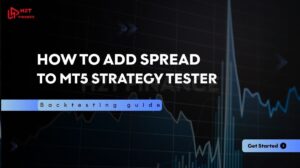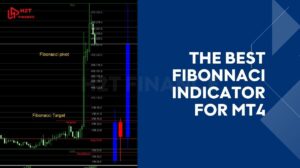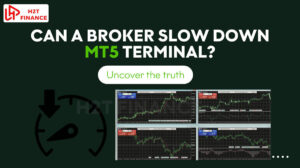Instead of being afraid, look at the number -7 as a sign that you are on a promising path. This could be the first signal on your journey to becoming a successful trader. You freeze. A knot tightens in your stomach. What on earth could this mean? Is it a lucky break, a golden ticket to easy profits? Or is it a devastating glitch, a trapdoor waiting to swallow your entire account?
If that jolt of confusion and the twinge of panic resonate with you, know this: you are not alone. That moment of doubt, where you question if you're a fool walking into a trap, is a rite of passage for every new trader. I’ve been there, too staring at the numbers, feeling a mix of wild hope and crushing disappointment as I tried to make sense of something that seemed utterly impossible.
But let's take a deep, calming breath. The truth behind this mystery is far simpler than the fear it inspires.
This guide isn't just about what does a spread of -7 mean; it’s about conquering the emotional rollercoaster that comes with it. We’ll demystify spreads, confront the impossible-looking numbers, and give you the confidence to distinguish a real market signal from a harmless but frightening glitch.
Key takeaways:
- What is a spread, really? In forex, the spread is the gap between what buyers are willing to pay (the bid) and what sellers are asking (the ask). It’s the invisible cost you pay every time you click “buy” or “sell.” For many beginners, it’s the first lesson in how brokers make money and why your trade starts in the red.
- So... a spread of -7? That can’t be right. A negative spread like -7 might look like a dream buying lower than the lowest ask? But unfortunately, it’s almost always a technical hiccup, not a real market condition. Delayed data feeds, buggy platforms, or misbehaving indicators can all be the culprits. I've seen it myself and trust me, it's more of a coding glitch than a golden ticket.
- Don’t get tempted. It’s easy to think, “Maybe I can profit from this anomaly!” But the truth is, negative spreads don’t last, and they’re not something you can act on. Between platform latency and how the market really works, there’s no real profit to be had here.
- What should you do instead? If you spot something strange like a negative spread, take a breath, then check the actual bid and ask prices, reload your platform, and double-check your indicators. Nine times out of ten, it’s just a display issue.
- Still new to all this? That’s okay. Use your demo account to explore how spreads behave in real time. Platforms like MT4 and MT5 offer reliable tools to track spreads and more importantly, help you build the confidence to question weird data before acting on it.
- One last thing: Don’t fall for the myths. Just because a spread is tight or even negative doesn’t mean it’s a better deal. Execution speed, platform reliability, and broker transparency matter just as much (if not more).
1. Understanding the basics: What is a spread in forex?
Before we dive into the puzzling question, “What does a spread of -7 mean?” It's really important to first get comfortable with one of the most basic, yet absolutely crucial, concepts in forex trading: the spread.
Understanding this foundation will make the rest of the journey feel a lot less confusing and way more manageable. Trust me, understanding this will make everything that follows a lot less intimidating.
1.1. What exactly is a spread?
In forex, the spread is simply the difference between the bid price (the highest price a buyer is willing to pay) and the ask price (the lowest price a seller is willing to accept) for a currency pair. For example, if EUR/USD has a bid of 1.1050 and an ask of 1.1052, that tiny 2-pip gap is the spread.
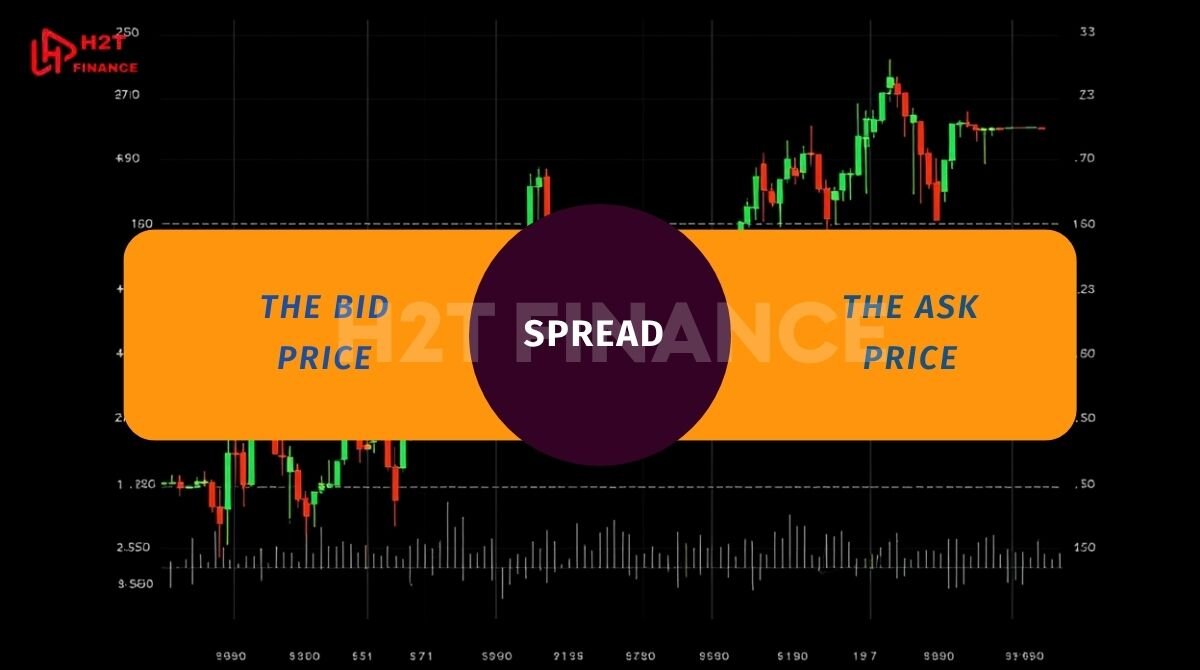
This small difference is essentially the cost of opening a trade, and it goes directly to the broker.
Spread = Ask Price – Bid Price
For traders, especially short-term ones like scalpers or day traders—the spread isn’t just a number; it’s something you feel the moment you hit the button. It quietly eats into your position before you even get a chance to breathe. Every trade starts slightly in the red, and that’s not just frustrating; it’s a constant reminder that the market charges a toll just to play the game.
1.2. Types of spreads in forex
There are two main types of spreads, each with its own personality:
- Fixed spreads: These are the reliable, but often more expensive, option. They remain constant, no matter how chaotic the market gets. They’re a comfort for traders who value predictability over everything else.
- Variable (or floating) spreads: These spreads are like a rollercoaster, they fluctuate wildly with market conditions and liquidity. While they can be incredibly tight and appealing during calm periods, they can also suddenly explode during major news events, catching unsuspecting traders off guard and adding to their anxiety.
1.3. Why does the spread matter?
Conquering your understanding of spreads is a powerful step. It empowers you to:
- Take control of your costs: You can stop feeling like you're paying a hidden tax and start accurately calculating your expenses.
- Trade with conviction: Choosing the right pairs and brokers becomes a strategic decision, not a shot in the dark.
- Protect your sanity: You learn to anticipate when spreads might widen, avoiding the panic of an unexpected loss when a major news release hits.
So, what is a spread in forex?
In simple terms, the spread in forex is the difference between the bid and ask prices of a currency pair and it quietly represents the cost you pay just to enter the market. It might seem like a small detail at first, but for beginners trying to make every pip count, that tiny gap can feel like a hurdle you didn’t even see coming. It’s one of those things that can make or break your profitability before the trade even has a chance to move.
Whether fixed or variable, spreads can shift depending on your broker, market conditions, and the currency pair you’re trading sometimes in ways that catch you off guard. If you’ve ever wondered why your trade didn’t quite break even when you thought it would, chances are the spread had something to do with it.
Understanding how spreads work isn’t just a technical checkbox; it’s how you protect yourself from unexpected setbacks. It gives you the confidence to enter trades with eyes wide open not hoping, but knowing what to expect.
And here’s where it gets a bit more curious: recognizing what qualifies as a “normal” spread helps you spot when something’s off like seeing a negative spread, say -7. It sounds bizarre, even impossible, at first glance. But is it really? In the next section, we’ll dig into this odd scenario and uncover what it actually means and whether you should be worried when it shows up.
2. What does a spread of -7 mean? Is it even possible?
At first glance, seeing a spread of -7 might throw you off — it feels confusing, maybe even impossible. After all, by definition, the spread is the ask price minus the bid price. So how on earth could that number ever dip below zero? It’s like the market is playing a trick on you.
In this section, we’ll unravel the mystery behind a spread of minus 7: whether it can actually happen, what it might mean in real trading, and how you, as a trader, should interpret and react when faced with such an unexpected figure.
2.1. Can a spread really be negative?
Theoretically, for most retail traders in normal market conditions, a spread simply can’t stay negative, it just doesn’t happen. But every now and then, in those rare moments on ECN platforms that pull prices from multiple liquidity providers, a strange thing called a “crossed market” can flash briefly: the best Bid price jumps above the best Ask price, almost like the market is playing a brief trick on you.
That said, these fleeting moments are nearly impossible to actually trade because of delays in data transmission, and they definitely don’t represent a genuine chance to make a risk-free profit. So, if you’re wondering whether you can exploit a negative spread the honest answer for traders like you and me is still a clear no.
So if you’re seeing a spread of -7 on your platform, it’s likely not a real market condition, but rather the result of one or more of the following:
- Data feed errors
- Platform bugs or display glitches
- Miscalculation of spread due to custom indicators
- Latency or lag between bid and ask updates
2.2. Is it something to worry about?
Seeing a minus 7 spread once or twice is usually not a major concern, especially if it corrects itself quickly.
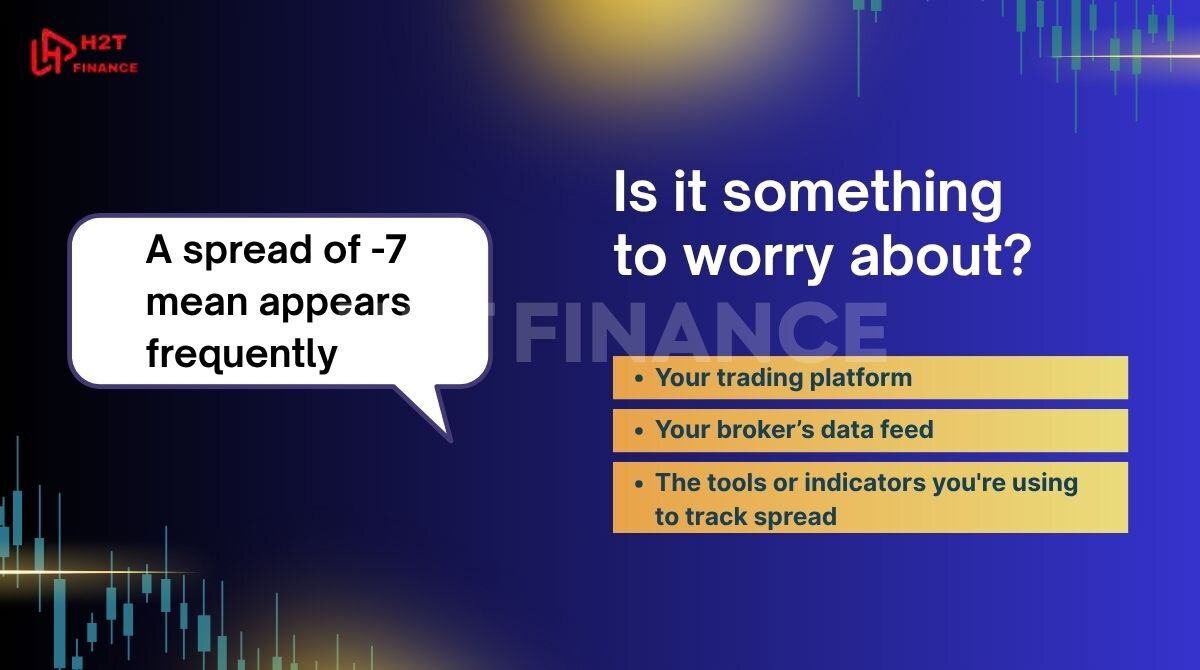
However, if it appears frequently, it might signal an issue with:
- Your trading platform
- Your broker’s data feed
- The tools or indicators you're using to track spread
I still vividly remember the very first time I spotted a price like this on my chart. For a brief moment, I felt like I’d stumbled into a “glitch in the Matrix” - a hidden secret, a golden opportunity staring right at me. My heart raced, but thankfully, I paused instead of rushing in.
If there’s one thing I’ve learned, it’s this: whenever something looks too good or just downright too strange to be true, that’s your gut telling you to slow down and dig deeper. Don’t jump in impulsively; treat it as a warning sign, not a green light to trade.
3. Why a negative spread may appear on your platform
If you’ve ever wondered, “What does a spread of minus 7 mean?” and why such a bizarre number suddenly pops up on your trading platform trust me, you’re definitely not alone. Many beginner traders see this and immediately jump to the conclusion that it must be a technical glitch. And honestly? Most of the time, they’re right.
But before you dismiss it, it’s worth understanding why and how a negative spread might show up, especially since the market itself isn’t supposed to allow it. There are actually several technical quirks or platform-related reasons behind seeing a spread of -7 or other negative values and knowing these can save you from unnecessary confusion or panic.
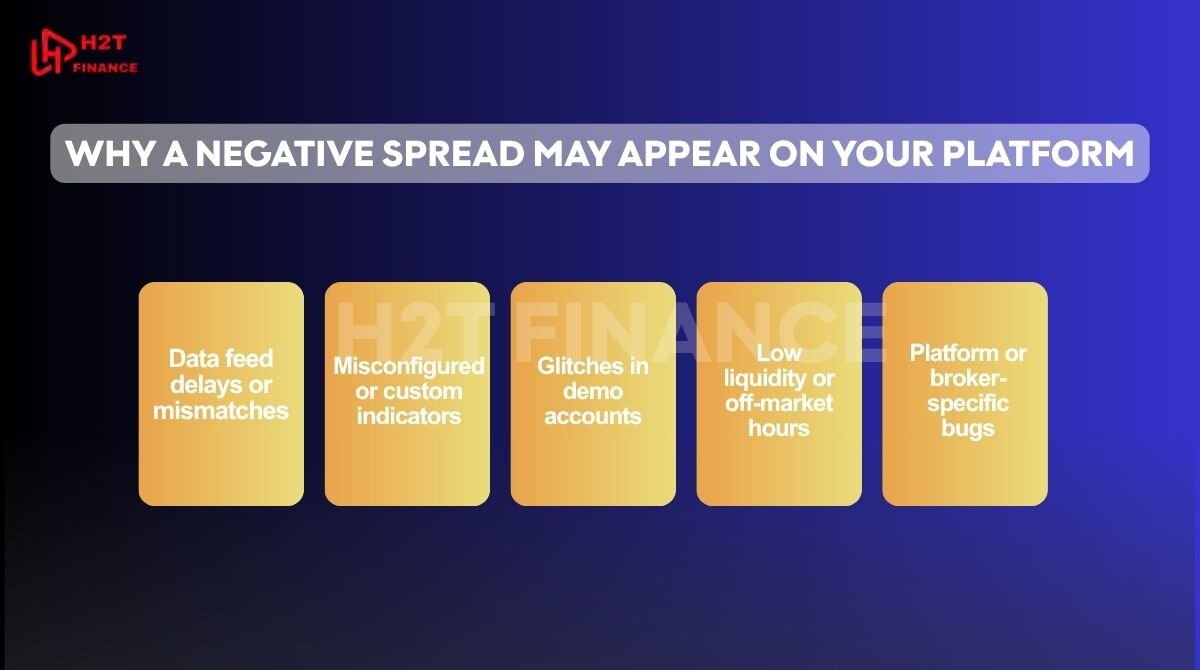
Here's a breakdown of the most common causes:
3.1. Data feed delays or mismatches
Your trading platform is constantly juggling bids and asking prices coming in from a data feed. Sometimes, even a tiny delay or mismatch between these two streams can throw things off. When that happens, your chart or custom indicator might briefly show the bid price as higher than the ask, creating a momentary negative spread that can feel confusing or like a glitch in the system.
3.2. Misconfigured or custom indicators
Many traders rely on third-party or custom indicators to keep an eye on the current spread. But if these tools aren’t coded quite right, especially in how they handle tick data, they can end up showing misleading numbers, like negative spreads of -7, even when the real spread is safely positive. It’s a bit like your trusted gauge suddenly sending you false alarms, causing unnecessary worry or confusion.
3.3. Glitches in demo accounts
If you’re trading on a demo account, it’s important to remember that demo environments don’t always keep pace perfectly with live market conditions. Many beginners get puzzled when they see strange spreads on demo platforms spreads that simply wouldn’t happen when real money is on the line.
This usually comes down to simplified execution engines or simulated liquidity, which are meant to mimic the market but can sometimes feel like playing in a slightly different game.
3.4. Low liquidity or off-market hours
During those quiet moments like late Friday evenings when most traders have signed off, or right after the market wakes up on Monday spreads can act a bit unpredictable, almost like they’re groggy from the weekend, according to CMC Markets.
Some platforms might even mess up how they calculate or display bid and ask prices during these times, especially for exotic pairs or CFDs. It can feel frustrating or confusing, but it’s just the market’s way of stretching before the real action begins.
3.5. Platform or broker-specific bugs
In some rare cases, the platform itself might glitch, or the broker’s price feed could momentarily break down. While this isn’t something you see often especially with regulated brokers, it’s worth keeping in mind, especially if you start noticing strange spread anomalies popping up again and again. It’s a little reminder that even the best systems can have their off days.
Should you trust your spread indicator?
In short, not always. If you see a spread of minus 7, it’s wise to:
- Cross-check with another platform or broker.
- Reload your chart or refresh the data.
- Compare your spread indicator with the raw bid and ask price feeds.
Ultimately, understanding that a negative spread is likely a display or calculation issue not a real market opportunity will help you avoid confusion and unnecessary worry.
4. How to deal with unexpected spreads in forex trading
Encountering a strange figure like a spread of -7 can really throw you off - especially if you’re a beginner still trying to wrap your head around how spreads actually work. It can feel unsettling, like the market’s sending mixed signals just when you want clarity the most.
While these oddities are usually just technical glitches rather than genuine trading opportunities or dangers, knowing how to react when they pop up is crucial. In this section, I’ll guide you through practical steps to handle these unexpected spreads with confidence, so you don’t let confusion shake your trading mindset.
Before we jump into the tips and tools, remember this: real trading is messy. There’s always noise. Part of becoming a successful trader is learning how to tune out the distractions—like weird spread readings and focus on what truly matters.
4.1. Tips for beginners
If you're just starting out, here are a few beginner-friendly guidelines to help you handle strange spread behavior:
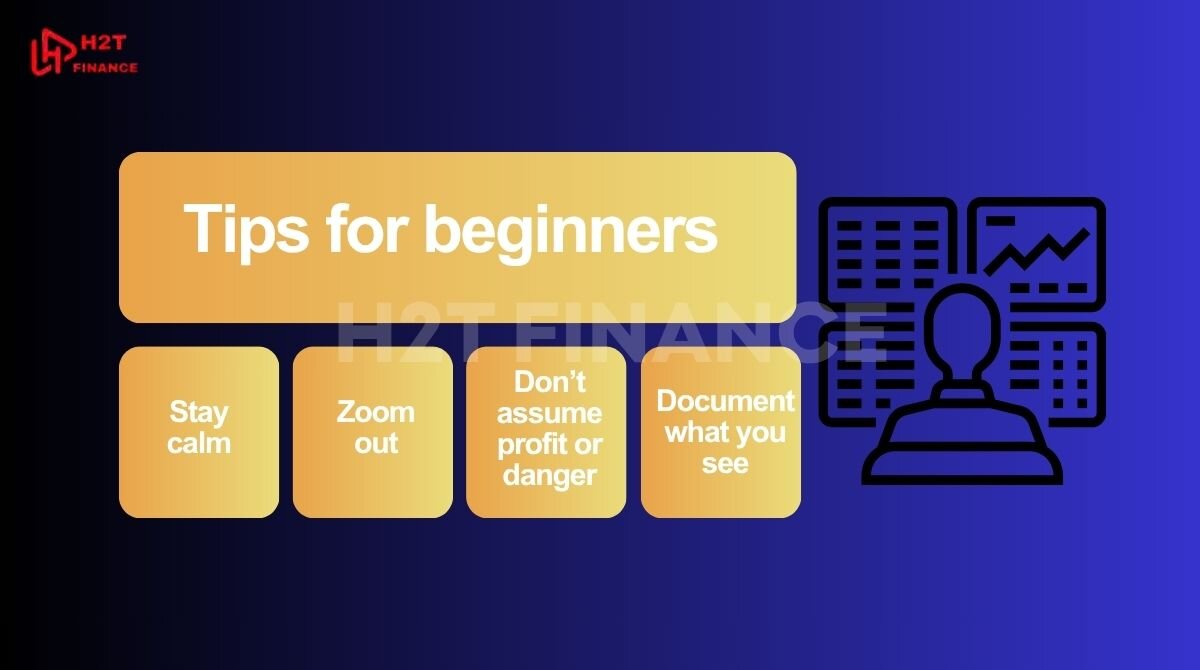
- Stay calm: Don’t rush into decisions based on a single spread reading. Take time to assess if it’s just a glitch.
- Zoom out: Look at the bid and ask prices directly rather than relying only on spread indicators.
- Don’t assume profit or danger: A negative spread might look like an instant win but it's likely not real. Avoid executing trades based on anomalies.
- Document what you see: Keep track of when and how negative spreads appear. This can help you diagnose patterns or issues with your platform.
4.2. Use demo accounts to test spread behavior
A powerful way to build confidence and spot issues is by testing spreads in a demo environment. Demo accounts let you:
- Safely observe how spreads behave in different market conditions.
- Test various indicators and data sources without risking real capital.
- Detect if a recurring negative spread issue is related to your platform or your trading logic.
While demo environments aren't always 100% reflective of live trading conditions, they’re still an invaluable tool for learning to spot and interpret spread anomalies.
Tip: Try simulating weekend trading or low-liquidity conditions on your demo platform to see how spreads react.
4.3. Tools and indicators to monitor real spread in real time
To monitor spreads more accurately and avoid being misled by incorrect data consider using reliable tools that allow real-time spread tracking:
- Built-in platform indicators: Most platforms like MT4, MT5, and cTrader have built-in tools or market watch windows showing real-time bid/ask prices.
- Custom spread indicators: Choose indicators from trusted sources that are regularly updated and well-reviewed by the trading community.
- Third-party tools: Services like TradingView or independent spread monitoring apps can provide a second opinion when your primary platform shows something strange.
Additionally, keep your indicators updated and tested in both demo and live environments. Any outdated or poorly coded indicator may cause issues like falsely reporting a spread of minus 7 when the actual spread is normal.
5. Common myths about spreads (including negative spreads)
For beginners navigating the world of forex trading, it’s easy to fall into misconceptions about how spreads work especially when encountering confusing figures like a spread of -7.
Let’s take a closer look at some of the most common myths surrounding spreads, and clarify what’s real versus what’s just trading folklore.
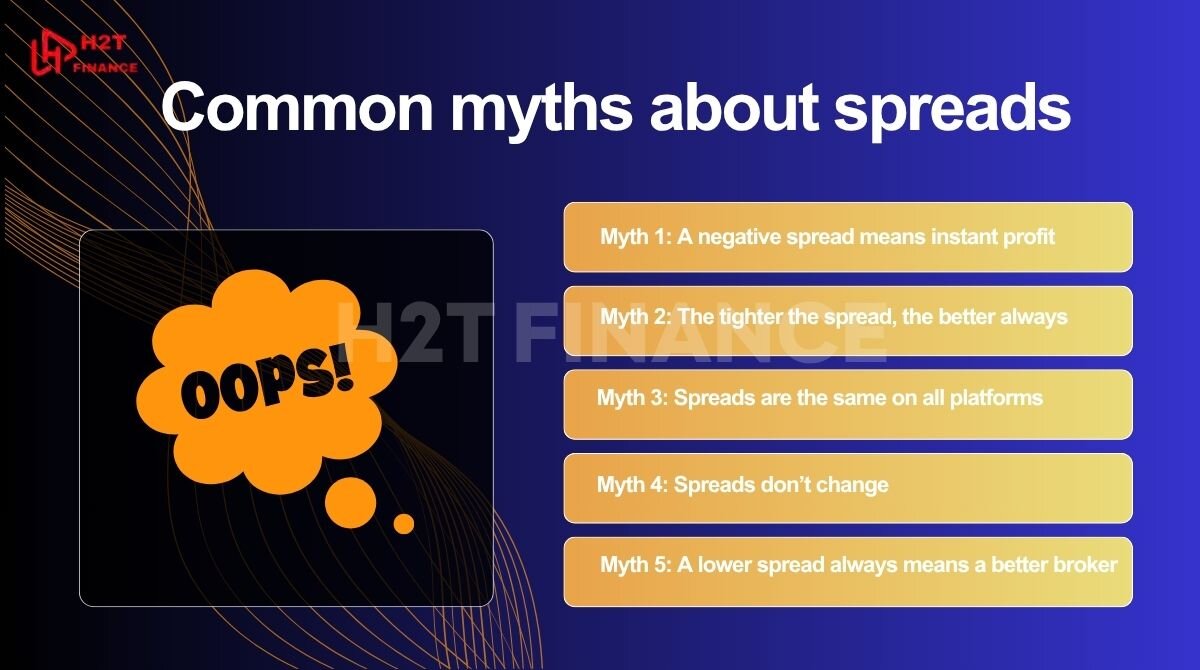
5.1. Myth 1: A negative spread means instant profit
This is one of the most misleading beliefs. A negative spread like -7 does not reflect a real profit opportunity you can exploit. It is almost always the result of a display error, an indicator bug, or a delayed data feed.
Even in the rare case of a true "crossed market," executing a trade to profit from it is nearly impossible for a retail trader due to factors like latency and slippage. Never consider it free money.
5.2. Myth 2: The tighter the spread, the better always
While tight spreads can feel like a dream come true, they’re not the whole story. Some brokers lure you in with super low spreads but then hit you with high commissions or shaky execution quality that can frustrate even the most patient trader.
And don’t be fooled during major news events spreads can suddenly balloon, even if your broker promises “fixed spreads.” The real trick is to look beyond just the spread and consider your total trading costs. After all, what seems like a great deal at first glance might end up costing you more than you expect.
5.3. Myth 3: Spreads are the same on all platforms
Not true, spreads aren’t a one-size-fits-all thing. I’m so frustrated when people act like they are. Every broker and platform has its own way of calculating and showing spreads, and it’s a big deal. Things like who provides the liquidity, the execution model they use (like ECN, STP, or Market Maker), and even what type of account you have can all change the spread you see.
That’s why a spread of -7 might pop up on one platform but be completely absent on another. It's so unfair to compare them directly. It’s a bit like comparing apples and oranges in the trading world, and it can be a real pain if you don’t know what to look for.
5.4. Myth 4: Spreads don’t change
I can’t believe some new traders assume spreads are fixed throughout the day! It’s a common misconception that can really hurt them. In reality, spreads fluctuate constantly, and it’s actually kind of exciting to watch. They change based on:
- Market volatility (when things get wild!)
- Trading session (like when the major markets open)
- News releases (major announcements can cause huge swings!)
- Liquidity levels (the more people trading, the better!)
For example, spreads often widen dramatically around major economic news events, and that’s completely normal. It’s a crucial lesson to learn early on, and it’s a shame when new traders get caught off guard by it.
5.5. Myth 5: A lower spread always means a better broker
I know, a tight spread might look incredibly appealing, but please, don't let it be the only reason you choose a broker! It’s a classic trap, and it drives me crazy when people fall for it. You need to look at so much more, like:
- Regulation and trustworthiness: Is the broker legitimate?
- Speed and quality of trade execution: Will your trades actually go through when you want them to?
- Transparency in pricing: Are they being honest about their fees?
- Support and platform stability: Can you count on them when things get chaotic?
Some brokers might offer a ridiculously low spread just to lure you in, only to manipulate prices or delay your orders later. It's a really sneaky tactic that can cost you a lot. Always, always do a full evaluation before you commit. It’s so important to protect yourself and your money.
Discover related blog posts in this section:
6. Common questions from beginner traders
6.1. Can a spread in forex be negative?
No, a negative spread isn’t possible in normal trading conditions. If you see one, it’s usually a technical error (e.g., platform glitch, faulty indicator, or data latency). It’s not a tradable opportunity.
6.2. Is a negative spread a good thing?
No. A negative spread is typically a display error, not a profit opportunity. Check the bid/ask prices and avoid trading based on this data.
6.3. How do I check if the displayed spread is accurate?
- View the raw bid/ask prices directly on your platform.
- Cross-check with another source like TradingView or a different broker.
- Use reliable, regularly updated spread indicators.
If irregularities persist, contact platform support.
6.4. Which platform shows accurate spreads?
MT4, MT5, and cTrader generally display accurate spreads if connected to a quality data feed. Accuracy depends on the broker and data quality. Test platforms with a demo account to compare.
7. Conclusion: What you should really do when seeing a -7 spread
So, after exploring all the angles, what does a spread of -7 mean? In the simplest terms, it means you've encountered a technical error, not a trading opportunity. To ensure you're always prepared, let's recap the key points:
- It's a technical issue: A negative spread signals a problem with the data feed, platform, or a custom indicator.
- Your response is key: Do not trade based on this number. Your job is to pause, verify the real Bid/Ask prices, and investigate the cause.
- It's not real profit: Any "opportunity" suggested by a negative spread is an illusion that cannot be captured in a live trading environment.
Understanding the real answer to "what does a spread of -7 mean" is a crucial step in your trading journey. At H2T Finance, we specialize in breaking down these complex topics in our Forex Basics series. Our mission is to replace confusion with clarity, helping you build the confidence to trade based on knowledge, not glitches.
